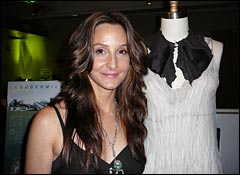Emily Gertz is an environmental journalist based in Brooklyn, N.Y., who has contributed to Grist, Plenty, WorldChanging, and other independent publications, and blogs at OneAtlantic.net.

Emily Gertz.
Thursday, 16 Nov 2006
New York, N.Y.
I want to believe.
I want to believe that we can create an ecologically sustainable and socio-economically just future for the billions of biologically distinct individuals who comprise humanity — and other-living-thingity — by going to sleep at night swaddled in soft organic-cotton sheets, waking up in the morning to garb ourselves in chic eco-fashions, and living out our days surrounded by beautiful, nontoxic furniture in our handsomely designed, LEED-certified homes.

Eco-designer Linda Loudermilk is a believer.
Photos: Emily Gertz
Lexus wants us to believe it, too — especially those of us (or those of you, I should say) in the market for the company’s mega-pricey LS hybrid luxury sedan, billed as “the ultimate in guilt-free pampering.” So the company hosted an “eco-showroom” in New York City featuring five high-end green-design entrepreneurs and an impressive selection of slow-food nibbles, to underscore the idea that being green doesn’t mean giving up the good life.
The shindig presented another opportunity to ponder the eco-culture questions of 2006: When policy and policymakers are missing in action, can the greening of business save the planet? And is there such a thing as conscientious consumption?
Once, a long time ago, I would have rejected anything that had to do with a car company, no matter how hybrid their sedan. But last night, while I rode the subway into Manhattan, I was reading Elizabeth Kolbert‘s latest climate-change dispatch in The New Yorker, about the accelerating acidification of the oceans. Does it matter so much, I began to wonder, if eco-salvation comes in the form of luxury — so long as we get there?
The evening’s green-minded and fashionable guests gathered at the furniture and materials showroom of Q Collection, in Manhattan’s Lower Broadway interior-design district. I’d first met Q founders Anthony Cochran and Jesse Johnson in early 2005 at the Verdopolis conference, and had been impressed with their approach to greening decor: find or develop sustainably sourced and health-safe materials, and use them to create frankly gorgeous furnishings that will appeal to high-end designers and their clients (think Interior Design magazine, not Mother Earth News). It had struck me at the time as a potentially effective mechanism for funding research and development for nontoxic home furnishing materials, which could then trickle down to goods sold at more modest price points.
Sure enough, Johnson told me that Q Collection is developing a line of fabrics made from recycled polyesters and safe dyes that will cost around $30 a yard, less than half the price of Q’s original textile line — as well as a collection of baby furniture and bedding. (Both will be introduced in spring 2007.) Q Collection has added key creative staff — the new director of furniture design and development jumped over from Martha Stewart — and has done well enough that it’s now directing 1 percent of its revenue to organizations raising awareness about indoor air quality, especially as it impacts the health of children and infants.
Johnson felt the goal of the evening, from the Lexus point of view, could be summed up in two words: no sacrifice. “Their hybrid buyer is not the Prius buyer,” he said. “It’s someone who would prefer to have better mileage and lower their ecological footprint, but without giving up the luxury features.”
On to Linda Loudermilk, a fashion designer out of Los Angeles with a punk-inflected, Stevie Nicks leather-and-lace air, and an eco-evangelical intensity. “I had an experience with nature that turned my life around,” said Loudermilk, adding that the story was too long to convey right then. “I was doing couture in Paris, but five years ago I picked up and moved to L.A. and started R&D on sustainable fabrics.” Her collection melds green-sourced materials, including “Ingeo,” a fiber made from non-GMO corn; sasawashi, a naturally anti-microbial leaf traditionally used for Japanese shoji screens; and lace made from wood pulp and nontoxic dye by a company in France that it took the designer three years to find.

Alexis and Jessica prove that green really is the new black.
All evening, two models outfitted in Loudermilk’s designs circulated around the showroom with the slightly detached air of aliens visiting from Planet Ectomorph. Alexis wore a floaty white halter top made from wood pulp and organic mousseline silk, and modeled Loudermilk’s recycled silver jewelry for me; Jessica’s skirt was a slim-cut number in shimmering gray Ingeo, her black top an elegant combination of silky-looking wood-pulp fabric and sustainable lace.
Loudermilk is developing a pan-fashion industry “luxury eco-certification” to help the public pick out the truly green goods; she expects to unveil it in December. The designer said she welcomed the Lexus connection. “The U.S. is the last country to accept high-style sustainable clothing,” said Loudermilk, whose clothes are carried in boutiques from the U.S. to Paris to Saudi Arabia, “but the first to give corporate support to sustainable designs.”
Other companies at the Lexus event included Kenneth Cobonpue, which offers modern furniture with organic shapes that company executive Christopher Reiter described as “alternatives to cold, clinical definitions of modern design.” Each piece is made in the company’s 300-person factory in the Philippines from locally sourced, rapidly renewable organic materials like bamboo, abaca, and rattan. Reiter emphasized that despite the absence of strong labor protections in the Philippines, the company employs only adults, who work an eight-hour day and get a fair wage. The designs draw on traditional weaving techniques to create what he called “functional art,” which also contributes to keeping the skills alive in the community.
Also present: LivingHomes, creator of prefabricated green homes designed by world-class modern architects. CEO Steve Glenn noted that they’re the first residences to attain LEED Platinum certification, the highest possible rating from the U.S. Green Building Council. The homes come in modules that can be constructed quickly — last April, Glenn’s own LivingHome in Santa Monica, Calif., was erected from 11 modules in about eight hours. (Finish work took another three months, according to Dwell magazine.) People who care about sustainability and design “have trouble finding homes that reflect their values,” said Glenn, explaining the company’s market. Right now, those people better have quite a lot to spend — but like Q Collection, LivingHomes hopes that as its market expands, it can begin to offer kits in a middle-class price range.
Jill Fehrenbacher, founder of the green design blog Inhabitat and architect-in-training at Columbia University, was enthusiastic about the LivingHomes approach: “It’s the most beautiful and eco-friendly pre-fab there is.” She didn’t discount the high cost of sustainable living represented at the party, however, or the dissonance of merging eco with luxe. “There could be a conflict between green and luxury,” she said. “Luxury is about consumption, which is essentially not green.”
Fehrenbacher didn’t see a problem with green products being targeted at the affluent, but advocated a thoughtful stance. “People need to constantly rein in the hype angle and refocus on the reason behind everything,” she said.
After grabbing a snack from the buffet, I chatted with long-time New York City eco-preneur Katherine Tiddens, who was there to cheer on designer Christine Nelson as well as the ascendance of green design. Nelson’s company, Coyuchi, creates embroidered organic baby linens, just the sort of thing Tiddens featured at her now-defunct Soho green boutique, Terra Verde. When Tiddens opened the store in 1991, she “wanted it to be the most radical and most seductive green store in the country,” she said — that is, one that didn’t look all hemp and patchouli oil. So she’s been happy to see the groundswell of interest in beautifully designed eco-friendly products.
But business can only do so much in a policy void, Tiddens said. A few businesses using nontoxic dyes won’t improve the lives or health of most consumers, but if the government bans a dye as too dangerous, then it will be gone. “Some things have to come from government,” Tiddens said. “There’s no time anymore to screw around.” (A post-Sept. 11 double whammy of lost business and tripled rent led Tiddens to shutter her Soho store a few years ago, but she says she’s still busy consulting on other projects, including an eco-resort on an as-yet-undisclosed warm island.)
As the evening wound down, I had come to no conclusions about business saving the world. My green roots are of a shade just deep enough that exhortations to buy more stuff — even eco-conscious, healthy stuff — ring a bit tinny. But then again, as Bruce Sterling writes in the Viridian Manifesto, “Civil society does not respond at all well to moralistic scolding … However, contemporary civil society can be led anywhere that looks attractive, glamorous, and seductive. The task at hand is therefore basically an act of social engineering. Society must become Green, and it must be a variety of Green that society will eagerly consume.”
The goods I’d seen this evening (including, I must admit, a lovely bag of swag) were damn seductive indeed. And I have to say, over the past two years, as more designers have started getting hip to environmentalism, the food at parties like this one has gotten a lot healthier and more tasty.
On the way out, I got another perspective from Chuck Heckman of the Delano Collection, one of the green entrepreneurs behind last winter’s ICI party. Delano spoke of that effort wistfully, as if it were from another era. “The first half of 2006 was like our 1990s period,” he said. “We all just said, ‘Hey, let’s have a party!'” But now it’s the 21st century. “Green business is no different from any other business,” said Delano. “We care more about issues. But it takes a lot of work. And in the end, it’s still about making dollars.”

